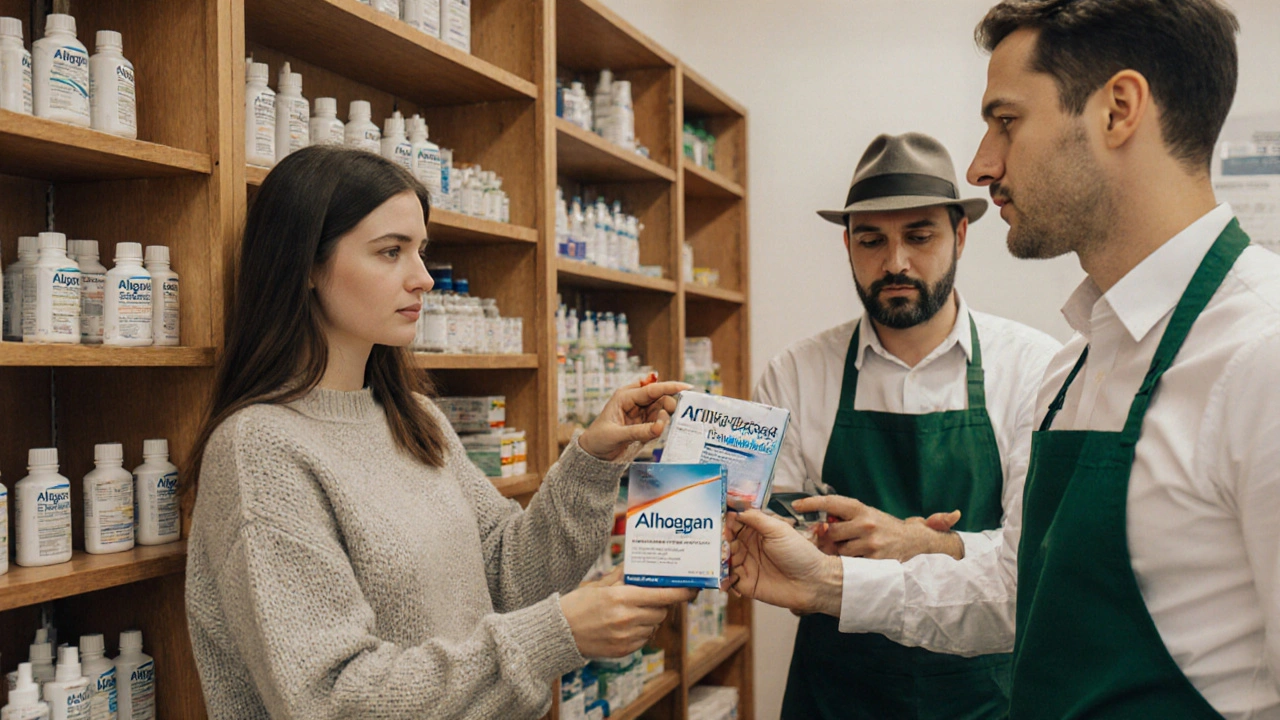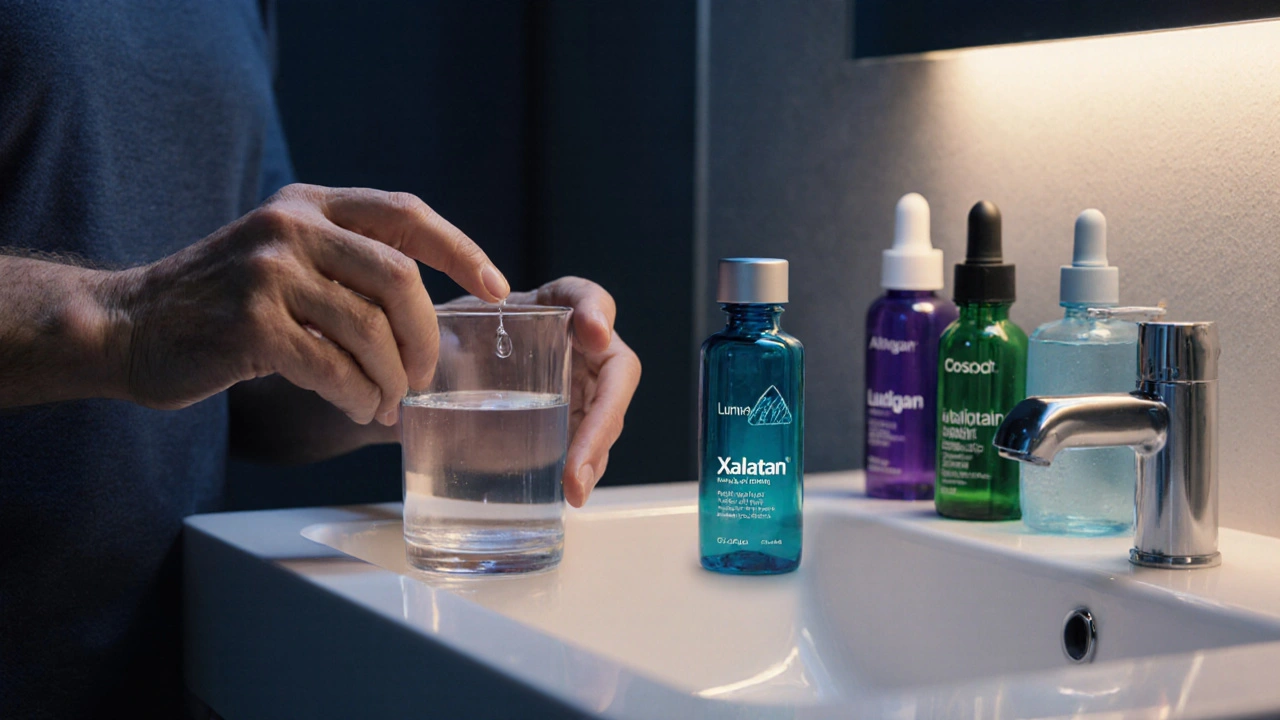Alphagan (Brimonidine Ophthalmic) vs Common Glaucoma Eye Drop Alternatives

Glaucoma Eye Drop Comparison Tool
Compare Eye Drop Options
Select your preferences to find the best matching glaucoma medication:
25%Quick Take
- Alphagan is a selective alpha‑2 agonist that lowers eye pressure by reducing fluid production and increasing outflow.
- It works well for mild‑to‑moderate open‑angle glaucoma and ocular hypertension, but can cause eye redness and fatigue.
- Prostaglandin analogues (e.g., Latanoprost, Travoprost) are usually more potent for chronic pressure control.
- Beta‑blockers (Timolol) are cheap and effective but unsuitable for patients with asthma or heart issues.
- Combination therapy-mixing Alphagan with a prostaglandin or a carbonic anhydrase inhibitor-often gives the best balance of efficacy and tolerability.
When you’re staring at a bottle of eye drops, the choices can feel endless. Below you’ll find a no‑fluff rundown of Alphagan, how it stacks up against the most popular alternatives, and a simple decision guide to help you pick the right drop for your eyes.
Alphagan is a brimonidine tartrate ophthalmic solution (0.15% or 0.2%) that lowers intra‑ocular pressure by stimulating alpha‑2 receptors in the eye, which reduces aqueous humor production and modestly increases outflow. It was approved by the FDA in 1997 and is prescribed for open‑angle glaucoma and ocular hypertension.
How Alphagan Works
Brimonidine binds to alpha‑2 adrenergic receptors on the ciliary body. This does two things: it tells the eye to make less fluid (aqueous humor) and it opens up tiny drainage channels called the uveoscleral pathway. The net effect is a pressure drop of about 20‑30% after a few weeks of twice‑daily dosing.
Key Benefits and Drawbacks
Benefits
- Fast onset - pressure often falls within hours of the first dose.
- Works well as an add‑on when a single drug isn’t enough.
- Doesn’t lower systemic blood pressure as much as some beta‑blockers.
Drawbacks
\n- Common side effects: eye redness, foreign‑body sensation, blurred vision, and mild fatigue.
- Effectiveness plateaus after a few weeks; many patients eventually need a second medication.
- Higher price point than generic beta‑blockers or some prostaglandins.

Alternative Eye Drops to Consider
Below are the most frequently prescribed drops that compete with Alphagan for the same indications. Each description includes a microdata definition for the first mention, so search engines can easily map the entities.
Timolol is a non‑selective beta‑adrenergic blocker (0.25% or 0.5%) that reduces aqueous humor production by blocking beta receptors in the ciliary epithelium. It’s been a workhorse since the 1970s and is often the cheapest option.
Latanoprost is a prostaglandin F₂α analogue (0.005%) that primarily increases uveoscleral outflow, making it the most potent single‑agent pressure reducer on the market. Administered once nightly, it can lower pressure by 30‑35%.
Travoprost is another prostaglandin analogue (0.004%) with a similar mechanism to latanoprost but a slightly different formulation that may be better tolerated by sensitive eyes.
Dorzolamide is a carbonic anhydrase inhibitor (2%) that reduces fluid production by blocking an enzyme needed for aqueous humor synthesis. It’s usually prescribed twice daily and can be combined with prostaglandins.
Netarsudil is a Rho‑kinase inhibitor (0.02%) that expands the trabecular meshwork, enhancing conventional outflow. It’s a newer option for patients who need an extra pressure‑lowering push.
Pilocarpine is a cholinergic agonist (1% or 2%) that contracts the ciliary muscle, opening the trabecular drainage angle. It’s less common today because of its short‑acting nature and side‑effects like brow ache.
Head‑to‑Head Comparison
| Drug | Class | Primary Mechanism | Typical Dose | Average Pressure Drop | Common Side Effects | Cost (USD per month) |
|---|---|---|---|---|---|---|
| Alphagan (Brimonidine) | Alpha‑2 agonist | Reduce production + increase uveoscleral outflow | Twice daily | 20‑30% | Redness, fatigue, bitter taste | ≈ $85 |
| Timolol | Beta‑blocker | Block aqueous production | Once or twice daily | 20‑25% | Bronchospasm, low heart rate, night vision blur | ≈ $15 (generic) |
| Latanoprost | Prostaglandin analogue | Increase uveoscleral outflow | Once nightly | 30‑35% | Darkened eyelashes, iris pigmentation, ocular irritation | ≈ $70 |
| Travoprost | Prostaglandin analogue | Increase uveoscleral outflow | Once nightly | 30‑35% | Eyelash growth, hyperemia, peri‑ocular skin darkening | ≈ $80 |
| Dorzolamide | Carbonic anhydrase inhibitor | Reduce aqueous production | Twice daily | 15‑20% | Metallic taste, bitter taste, stinging | ≈ $30 |
| Netarsudil | Rho‑kinase inhibitor | Increase trabecular outflow | Once daily | 20‑25% | Conjunctival hyperemia, pain, cornea verticillata | ≈ $120 |
Decision Guide: When to Pick Alphagan
Use the following quick‑check list to decide if Alphagan is the right first‑line or add‑on therapy for you.
- Pressure target needs modest reduction (20‑30%). If you’re already on a prostaglandin and still above target, consider adding Alphagan.
- Systemic health constraints. If you have asthma, COPD, or a low heart rate, beta‑blockers like Timolol are risky, making Alphagan a safer choice.
- Cost sensitivity. Alphagan is pricier than generic timolol but cheaper than many branded prostaglandins when you factor in insurance co‑pays.
- Side‑effect profile preferences. If you dislike darkening of eye color (a prostaglandin effect) but can tolerate mild redness, Alphagan may feel more agreeable.
- Adherence considerations. Twice‑daily dosing fits into morning and evening routines; if you struggle with dosing frequency, a nightly prostaglandin might win.
Practical Tips & Common Pitfalls
- Always shake the bottle gently before using; brimonidine can settle.
- Wait at least five minutes between different eye drops to avoid wash‑out.
- Store Alphagan at room temperature; don’t freeze it, as the solution can crystallize.
- Report persistent eye redness or severe fatigue to your ophthalmologist-sometimes a dose reduction to 0.15% helps.
- If you’re switching from a beta‑blocker, keep an eye on heart rate for the first few days; a brief dip can happen.

Frequently Asked Questions
Can I use Alphagan if I have dry eye?
Yes, but you may notice a temporary stinging sensation. Using preservative‑free artificial tears a few minutes after the drop can ease discomfort.
How long does it take to see the full effect?
Most patients notice a pressure drop within a few hours, but the maximum reduction usually stabilizes after 2‑4 weeks of consistent use.
Is it safe to use Alphagan with other glaucoma drops?
Generally, yes. Alphagan is often combined with a prostaglandin or a carbonic anhydrase inhibitor to hit complementary mechanisms. Talk to your eye doctor about timing to avoid wash‑out.
What should I do if I miss a dose?
Take the missed dose as soon as you remember, unless it’s almost time for the next one. In that case, skip the missed dose and continue with your regular schedule-don’t double up.
Are there any long‑term risks with Alphagan?
Long‑term studies up to five years show stable pressure control with no increased risk of cataracts or severe systemic effects. However, persistent ocular redness may indicate a need to switch or add another medication.
Choosing the right glaucoma eye drop is a balance of effectiveness, safety, cost, and lifestyle. Alphagan comparison shows that while it’s not the most powerful single agent, its unique mechanism and tolerability make it a solid option-especially when other drugs are contraindicated or cause unwanted side effects. Talk with your eye specialist, weigh the pros and cons outlined above, and you’ll land on a regimen that keeps your pressure down and your vision clear.

kevin tarp
September 29, 2025 AT 03:08The table is mostly correct, but the cost column should be labeled "USD per month" for clarity. Also, note that "Alphagan" is spelled with a capital "A" throughout. Overall, the data aligns with typical clinical findings.
ravi kumar
October 9, 2025 AT 13:08Look, in India we have access to generic brimonidine that costs a fraction of the US price, and the efficacy remains comparable. The article fails to mention that the pharmaceutical market is not monolithic, and local pricing can dramatically change the cost‑benefit analysis. Also, many patients prefer prostaglandins because of once‑daily dosing, yet the side‑effect profile of darker lashes is often overlooked. It's crucial to factor in regional health policies when evaluating "best" options. Ignoring these nuances makes the comparison feel Western‑centric.
SandraAnn Clark
October 19, 2025 AT 23:08Eye drops are like life, you pick one and hope it works.
Rex Wang
October 30, 2025 AT 08:08Nice summary, really clear, I appreciate the concise tables, and the practical tips help a lot.
mark Lapardin
November 9, 2025 AT 18:08The mechanistic breakdown is spot‑on; brimonidine’s dual action on production and outflow distinguishes it from pure beta‑blockers. While cost is higher, insurance formularies often mitigate out‑of‑pocket expense. Combining it with a prostaglandin leverages complementary pathways and can achieve additive pressure reduction. It’s a reasonable add‑on before moving to combination products with fixed‑dose bottles.
Barry Singleton
November 20, 2025 AT 04:08From an analytical standpoint, the efficacy delta between Alphagan and latanoprost is statistically modest, yet the side‑effect burden tilts the risk‑benefit ratio. The article could benefit from citing head‑to‑head RCT data rather than anecdotal observations. Moreover, the cost analysis omits long‑term adherence impacts, which are crucial for glaucoma management.
lee charlie
November 30, 2025 AT 14:08Great info! It’s helpful to see both pros and cons laid out. I feel more confident choosing a regimen now.
Greg DiMedio
December 11, 2025 AT 00:08Wow, another "comprehensive" guide that forgets to mention the real cost of eye‑drop fatigue. Guess we’ll just keep guessing.
Badal Patel
December 21, 2025 AT 10:08Behold! A most august exposition upon ocular therapeutics; yet one must query: why doth the author neglect the venerable musings of ancient Ayurvedic ocular tonics?-Are we to trust only the western pharmacopeia?~ Surely, a balanced discourse would encompass all traditions, not merely the market‑driven selection.